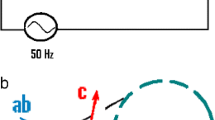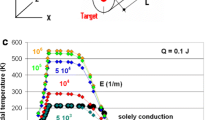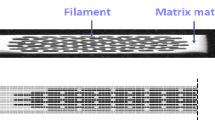Abstract
Stability functions are an important analytical/numerical tool for appropriate design of conductor geometry and dimensions to prevent conductor losses under a transport current. While standard stability calculations following the Stekly, adiabatic, or dynamic stability models apply purely solid thermal conduction mechanism and derive results under (quasi) stationary conditions, the present paper investigates if, and to which extent, also radiation heat transfer, in addition to solid conduction, can exert impacts on conductor stability. Further, the full transient conductor temperature evolution after a disturbance is calculated. The analysis applies an interplay between Monte Carlo radiative transfer calculations, to describe absorption of heat pulses and their distribution in the conductor, and a rigorous finite element method to calculate the resulting temperature field and stability functions. The results show that radiative heat transfer cannot be neglected in particular if periodic disturbances have to be considered that can arise, e.g., in a flux flow fault current limiter.















Similar content being viewed by others
References
Wilson, M.N.: Superconducting magnets. In: Scurlock, R.G. (ed.) Monographs on Cryogenics. Oxford University Press, New York (1989). Reprinted paperback
Dresner, L.: Stability of superconductors. In: Wolf, S. (ed.) Selected Topics in Superconductivity. Plenum Press, New York (1995)
Flik, M.L., Tien, C.L.: Intrinsic thermal stability of anisotropic thin-film superconductors. In: ASME Winter Ann. Meeting, Chicago, IL, Nov 29–Dec 2 (1988)
Reiss, H.: An approach to the dynamic stability of high-temperature superconductors. High Temp., High Press. 25, 135–159 (1993)
Reiss, H., Troitsky, O.Yu.: Radiative transfer and its impact on thermal diffusivity determined in remote sensing. In: Reimer, A. (ed.) Horizons in World Physics, vol. 276 (2011). Open access paper
Parker, W.J., Jenkins, R.J.: Thermal conductivity measurements on bismuth telluride in the presence of a 2 MeV electron beam. Adv. Energy Convers. 2, 87–103 (1962)
Reiss, H., Troitsky, O.Yu.: The Meissner–Ochsenfeld effect as a possible tool to control anisotropy of thermal conductivity and pinning strength of type II superconductors. Cryogenics 49, 433–448 (2009)
Djupmyr, M.: The role of temperature for the critical current density in high-temperature superconductors and heterostructures, Doctoral thesis, University of Stuttgart, Germany (2008)
Janos, K., Kus, P.: Temperature dependence of the critical current density in Y–Ba–Cu–O thin films. Czechoslov. J. Phys. 40, 335–340 (1990)
García-Fornaris, I., Planas, A., Muné, P., Jardim, R., Govea-Alcaide, E.: Temperature dependence of the intergranular critical current density in uniaxially pressed Bi1.65Pb0.35Sr2Ca2Cu3O10+δ samples. J. Supercond. Nov. Magn. 23, 1511–1516 (2010)
Chu, Sh., McHenry, M.E.: Critical current density in high-T c Bi-2223 single crystals AC and DC magnetic measurements. Physica C 337, 229–233 (2009)
Youssef, A., Banicova, L., Svindrich, Z., Janu, Z.: Contactless estimation of critical current density and its temperature dependence using magnetic measurements. Acta Phys. Pol. A 118, 1036–1037 (2010)
Kamarás, K., Herr, S.L., Porter, C.D., Tache, N., Tanner, D.B., Etemad, S., Venkatesan, T., Chase, E., Inam, A., Wu, X.D., Hegde, M.S., Dutta, B.: A clean high-T c superconductor you do not see the gap. Phys. Rev. Lett. 64, 84–87 (1989). Erratum: 64, 1692 (1990)
Chen, M.: Optical studies of high temperature superconductors and electronic dielectric materials. Doctoral thesis, University of Florida (2005)
Author information
Authors and Affiliations
Corresponding author
Appendix
Appendix
If not available from transmission measurements, extinction coefficients for the superconducting and normal conducting states can be estimated from literature values of spectroscopic measurements of reflectivity and corresponding Kramers–Kronig analysis. From the large variety of reflectivity measurements with high temperature superconductors reported in the literature, we in the following apply results from Kamarás et al. [13] and Chen for YBaCuO [14]. First, Kamarás et al. [13] showed that the mid-infrared absorption is a direct electronic absorption, with an onset at 140 cm−1 in YBa2Cu3O7−δ . The authors find that absorption across the gap is weak because the investigated high-T c materials was in the clean limit, and this weak absorption is masked by the mid-infrared absorption. Chen [14] then applied a two component mode for the dielectric function. Figures 3.13 and 3.17 in this reference exactly cover the region of wave numbers to be considered in the present paper. From the complex optical conductivity for optimally doped YBaCuO, σ=σ 1+iσ 2, a mean value of the extinction coefficient, E=4πk/Λ, in the order of 107 m−1 in the superconducting state at a mean Λ=50 μm has been estimated on basis of the usual relations n 2−k 2=ε 1 and 2nk=ε 2=2σ/ω, with k the imaginary part of the index of refraction, ε 1,2 the real and imaginary part of the dielectric constant, and ω the frequency. In the normal conducting state, the spectral response of the optical conductivity, in particular at small wave numbers, is clearly different. Both real and imaginary parts of the optical conductivity are definitely smaller than in the superconducting state (the imaginary part by at least an order of magnitude). This means also the extinction coefficient is reduced, to a mean value of about E=5×106 m−1 taken over the same interval of wave numbers. Also, note that the analysis in [14] was applied to thin film samples prepared by pulsed laser ablation from a stoichiometric YBaCuO-target onto SrTiO3 substrates. For the wire modeled in the present paper, we instead expect a polycrystalline material with smaller extinction coefficient than the values obtained from the optical conductivity reported in [14] (the absorption coefficient, A, is definitely smaller, but there will be some scattering contributions, S=ΩE, to the total extinction coefficient).
Accordingly, Monte Carlo calculations were performed for the series 5×103≤E≤106 m−1. If the series would be continued up to E=107 m−1, the mean free path, l m , of the bundles between two interactions becomes very small, l m =0.1 μm, and the optical thickness, τ, of the sample in y-direction accordingly very large, τ=4×104. Such a large number of absorption/remission and scattering events would very strongly increase computation time in the Monte Carlo analysis to unacceptably long periods of time (this extends to the order of days on a PC under Windows XP using a 3.8 GHz processor and 4GB work space).
Rights and permissions
About this article
Cite this article
Reiss, H. Radiation Heat Transfer and Its Impact on Stability Against Quench of a Superconductor. J Supercond Nov Magn 25, 339–350 (2012). https://doi.org/10.1007/s10948-011-1314-2
Received:
Accepted:
Published:
Issue Date:
DOI: https://doi.org/10.1007/s10948-011-1314-2




